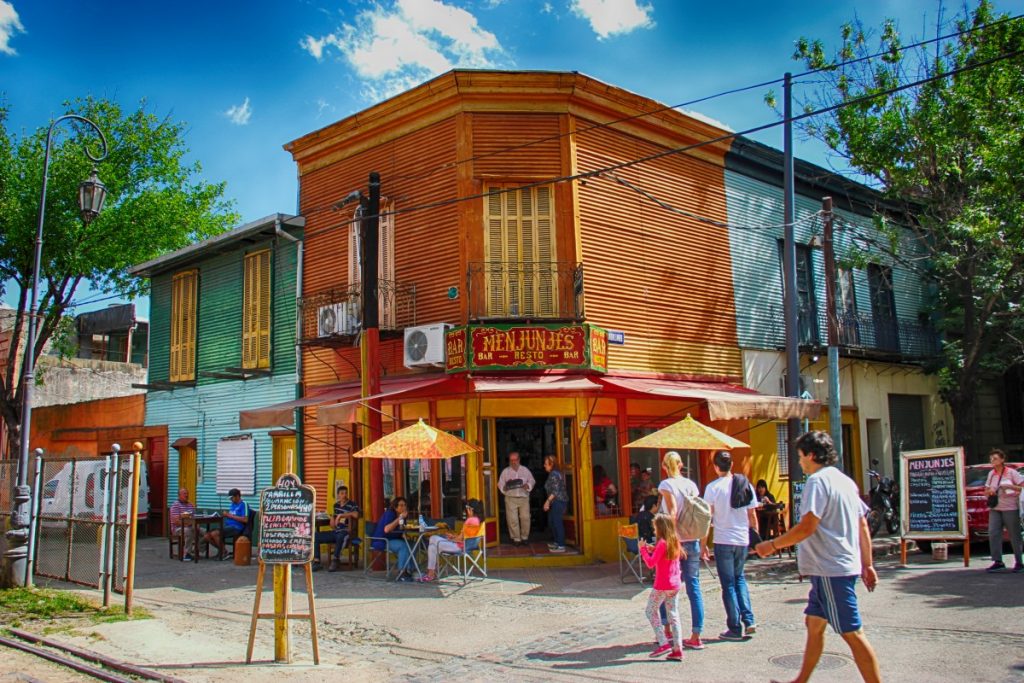
Deconstructing Argentine whiteness: a conversation with Afro, Indigenous and “Marrón” intellectuals
By Ana Vivaldi and Pablo Cossio
(Translation by Peter Wade)
The myth of a white Argentina is as powerful and persistent as it is false. However, also powerful and long-standing are the challenges to this common-sense understanding, which, from a cultural and political perspective, propose pluralistic ideas of the nation, and demand spaces for the lives of Afro, indigenous and “marrón” (brown) people. We spoke with Alejandra Egido, director of Teatro en Sepia, a company of Afro-descendant women; Miriam Alvaréz, teacher and director of El Katango, a Mapuche theatre company; and Lorena Cañuqueo, teacher and member of the Mariano Epulef “lof” (Mapuche community). And, from the Identidad Marrón artistic collective, we also talked with Flora Alvarado, educator and artist; América Canela, teacher; Abril Carisimo, visual artist; and Alejandro (Joma) Mamani, lawyer. From 2020, we have worked together in a collaborative research team on Cultures of Anti-Racism in Argentina. We reflect on the difficulty of discussing racism in Argentina, and we review the many experiences which inform the interviewees’ anti-racist practices.
There was much talk last month about the remarks of President Alberto Fernández who repeated the idea of an Argentina that “descends from ships,” i.e. is a product of the European waves of migration that began at the end of the 19th century; remarks that he later retracted and that in fact contradict the government’s own policies. However, these statements are a symptom of the continuing existence of the idea of a white Argentina, a Eurocentric legacy that assumes that these migrants arrived in an empty land. It is a myth that depicts Argentina as a “failed” settler society, putting it on a footing with North America and Australia, an Argentina that is also considered white by most Latin Americans. But what do those who lead cultural and political resistance against structural racism in Argentina have to say? In this piece, we focus on their experiences, practices and perspectives.
Ana: All of you reacted to Fernández’s statements but also indicated a lack of surprise at them, and even a sense of weariness. Lorena mentioned scepticism; America circulated a meme saying “You all need to overcome the myth of the White Argentina. Seriously, it is pasé”; a note from the Gender Section of the 8th of November Commission, of which Alejandra is a member, emphasizes that this racist myth is shared by the entire continent. How does it impact you in your daily life, and in your professional, artistic and political practices?
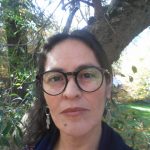
Miriam Alvarez
Miriam: Something simple and every-day comes to mind. On the one hand, in my daily life, the common-sense understandings of society do not relate to me as a professional, a university teacher. On visits to the doctor, when I take my son or accompany my parents, the affirmative question was: are you a waitress or a supermarket cashier? I don’t mean to belittle these jobs, of course: my father was a restaurant worker for thirty years and my mother a domestic worker and that is what is expected of our population. On the other hand, when I say that I am Mapuche, people distrust me and I must explain everything, bringing my grandparents and great-grandparents into it, and explaining that my mother grew up in a Mapuche community; and it is still not enough because I am a professional, I do not have a Mapuche last name and I do not live in the countryside. So they don’t allow me to occupy any place. We cannot occupy any space. They displace us from our territory, they push us into the city and on top of that they take away our identity in the city, because it is not our territory.
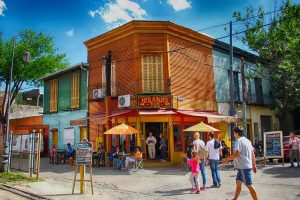
Middle-class neighbourhood in Buenos Aires
Alejandra: For me personally it is a debate that has tired me out: “Talk about raining on wet ground” as Silvio Rodríguez would say. This controversy has exhausted the one thousand and one creative strategies that I have devised to bring this issue to the public arena through my artistic creations. I think no one is interested in recognizing Afro descent as part of the composition of the Latin American population: not people, not societies, not Latin American governments. A residual racism appears in these debates, the legacy of a doctrinal racism, an ideology which justified the colonial system, the slave trade and filled its coffers. But ultimately both ideologies have prevented the social incorporation of our ethnic group in conditions of full equity.
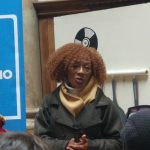
Alejandra Egido
It is surprising that we are part of a technological revolution in which we are participants, connected to a large network of devices where all are interconnected thanks to the Internet and at this point no one can correctly refer to a phenotypically racialized person, using terms such as black, or Afro-Latin American or Afro-Argentine. I have witnessed people who, trying to be as courteous as possible, have wanted to refer to my ethnicity and have broken out in a cold sweat; the tongue-twisting they’ve done, I swear it’s unspeakable. In truth, Afro peoples and communities are part of Latin American national realities, in the same way as native peoples, so however hard it is to bear and even though I am tired of it, we are facing a debate that concerns us all and we must take it forward, bringing racialized voices to the forum.
April: For the art professional, who is racialized and Argentinian, the myth of white Argentina has two consequences: how we are perceived and how we internalize this official story. In Argentina the processes of staging in the artistic field constantly involve different forms of exclusion, be they class, ethnic, or gender. Living with these ways of categorizing the creators and their productions implies, most of the time, inhabiting the artistic space while being pigeonholed either by exoticizations or by institutional instrumentalizations of one’s identity. We are trapped within stereotypes or stigmatizing archetypes, and we face the choice of taking on a pedagogical role or just being the trauma that racism leaves behind.
All of us, racialized and not, internalize who can inhabit the culture and how, and who can exist without being accountable to anyone. Beyond making it difficult to navigate these spaces and their dynamics, what this hinders to begin with is one’s perception of one’s own work, putting value on one’s work, understanding that what one does is work, starting to recognize one’s own experiences as something worth talking about, and to understand them in a systematic context (understanding one’s own experience as a racialized and collective one). As art professionals, being able to speak from within these ambiguities and aesthetics – which are in a process of construction – being able to make them a priority, implies being able to let oneself live in fantasy, possibilities and reflections all together. But at the same time, we live with the weight that these invisibilizing myths have on how we ourselves understand each other and act and translate amongst us. Above all we have to live with how white spaces, how institutionalized politics and art, see, consume, assimilate and capitalize on our discourses.

Abril Carisimo
Inhabiting the peripheries, both the inside-outside of the institution, the identitarian limbo, the self-censorship that arises from inhabiting different spaces, such as the territorial peripheries, such as going to and from CABA [Autonomous City of Buenos Aires] that is implied by living in the interior of the country or the suburbs of Buenos Aires, means navigating places under the idea of otherness that institutional discourses impose. This is very similar to inhabiting the transformative and ambiguous idea of marrón [brown]: it is inhabiting the process, urgency, collaboration, contingency, breaking out of the stereotype, using the stereotype, defamiliarising, making do with whatever one has and finally, ideally, being able with our words, images, references and heterogeneous and mestizo cultures, to understand and continue to develop the multiplicity of perspectives and productions that come out of racialized people. We all grew up with these same myths and stagings, and questioning them, making them more complex, and transforming them is a conscious and constant process of work, which also happens every time that more racialized voices can be present or question institutional spaces and discourses.
Joma: When we talk about making racism visible and what the current situation is, first, what we always have to bear in mind is the taboo of talking about racism in Argentina in particular, and in Latin America in general, as one of the key characteristics. Then comes the necessity of the link endorsed, often by the law and inspired by the logic of Anglo-Saxon international law, endorsed by them, with respect to the context of the global north, then it is, by means of antonomasia, the thinking that links racism to Afro-descendants.

Alejandro Mamani
So, the problem of racism towards indigenous people or people of indigenous descent, brown people, peasants and migrants and others, is a super complicated issue, not only from a structural-legal angle but also because of the social perception that cannot understand racism from that place. That seems necessary to me before talking about the visibility of racism. Then, in the closer cases where the State tries to make racism visible by means of projects, plans or public policies, they are generally linked to the issue of Afro-descendants – which is not bad, because clearly the invisibilization of the transatlantic trafficking of Afro people, who are today’s Afro-descendants, is super present, so it seems necessary to speak from that place, when we talk about structural racism.
Ana: Each of you is contesting this invisibilization, seen as a historical tension. The challenge is to construct a nation that recognizes that indigenous, Afro and brown people always existed and are part of the Argentine social formation. Ale talks about how every time she has to present herself as Afro she has to explain her existence going back to 1489 and Columbus’s invasion of America. But at the same time, the work you have been doing is in relation to being trapped within a stereotype. That is to say, you see the problem is that recognition is limited to being only folkloric figures that appear in a festival as a curiosity. The images of Afro dancers, of indigenous people in traditional clothes in remote areas, of aggressive and marginalized brown people (in current TV series about the shantytowns). Your work then looks for forms of representation that complicate traditional stereotypes and archetypes. Can you tell us, what are the issues around fighting for inclusion in the nation on the one hand and, on the other, questioning stereotyped representations? How do you work to construct alternatives?
Flora: The problem of inclusion is that many times it arises only as the presence on particular dates of groups that are affected, let’s say brown people, indigenous people or people of indigenous descent. Often these inclusive proposals that seek to go against the norm are confined to particular issues such as being present on those particular dates – the Day Against Racism, October 12th, for example – and there is no real inclusion that could be reflected in jobs for these people so they could be included in these systems. Often they do not turn up or, if they come, it is very difficult for them to stay. Because generally brown people belong to the lower social classes, and, being able to see these structures and being able to think of a real inclusion that really makes changes in people’s lives, they begin see that this “inclusion” does not involve a real change, in addition to the fact that often those who think up and put together these representations or organize, schematize and generate the scripts, who are in the creative part, are people who often have no notion of the issues they are talking about. Training is needed for the creative sectors of, let’s say, the advertising agencies to be able to begin to propose a real change in how these representations are created. The aim is to break out of the stereotype, however, if we just put in a brown person without rethinking the context in which he appears – what are the stories we want to tell, what are the narratives we are coming from, and which are the ones we want to construct? It is often difficult to break out of these schemes, and it will be more difficult really to be able to propose other possibilities of existence or other possibilities of representation.
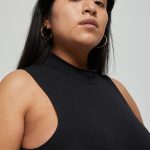
Florencia Alvarado
In response to “how do you work to build alternatives?”: We always begin by asking ourselves and questioning, well, what do we see, what do we consume, what do we know? We come from the popular sectors and in our homes, for example, often in our homes, on the television – of the things that are consumed on a daily basis: television, newspapers, magazines, advertisements that we see on the street… In these images there is a lot of information about which places we occupy, and which places white people occupy in all these spaces. It is white people who are mostly represented in advertising or mass media, but Argentina is a country with many people of indigenous descent who may not know it or do not recognize it. However, these people exist, so why not do we find them in those places?
For us, a way to rethink or question ourselves, and at the same time, to take some action, is by generating these images. It is not just a matter of asking questions, it is also understanding that we can find ourselves in any sphere, we can find ourselves in the spheres of ancestral cultural practices, we can find ourselves in the sphere of the city, we can find ourselves in the sphere of academia, and in different political positions. It is a reality too, but it seems strange to us and in fact we understand why. We emphasize that we are everywhere so why aren’t we seen? On the other hand, another possibility, beyond creating other types of representations, is also to begin to consider the work of people in groups or associations that are working on the issue of racism; it is necessary to work together with these people, or people who are located in the [indigenous] territories; those people should be consulted. It is necessary to ask yourself about this information and about how to create other types of representations; it is necessary to broaden the gaze, the perspective. Collective work is also needed to be able to start putting together something different from what is already known, what already exists; and this is not achieved from one side only, it is achieved by being able to generate ties, connections, networks in which the voice of people who have never been heard begins to be heard and begins to have an impact on the social imaginary, the popular imagination, of how, for example, we are seen.
Pablo: 2020 can be thought of as a key moment in the visibilisation of racism as a problem in Argentina, putting it on the agenda, partly due to the repercussions of #BLM, but also due to the initiatives of the government itself, activating policies on a national level. The president spoke in the congress of historical reparations; the figure of Remedios del Valle (a female Afro general involved in the wars of Independence) was recognized; racism against brown people was recognized. In 2020, all of you were protagonists in putting racism on the agenda and setting the terms of the debate. How do you see the reach of this visibilisation of racism; what is the state of the debate?
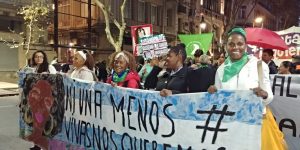
Feminist march in Buenos Aires
Lorena: I don’t know how other Mapuche people see it, but I think that this visibilisation is not generalized and is limited to specific domains – urban locations and activism, or academics who had already been working on the issue before #BLM. What does continue is racism in this region of Patagonia, because the conditions that make it possible – from judicial evictions to the intimidation that Mapuche and Mapuche-Tehuelche communities suffer on a daily basis – have not ceased. Every day we learn that the Ministry of Justice questions the legitimacy of the communities’ status as indigenous or rules against them without even evaluating the evidence they present. The provincial administrations cede land rights to companies, businessmen or members of the privileged sectors of local areas and deny the rights that Mapuche and Mapuche-Tehuelche families and communities exercise based on their traditional and historical occupations.
Also the ceding of rights on the plateaux of Río Negro and Chubut [provinces] to international mining companies, and of rights to water sources in the mountain ranges, show this deeply-rooted racism: the indigenous people are not consulted, they are subordinated until they manage to build an oppositional force that prevails. But also, the fact that the media continues to reproduce stigmatizing images and discourses about indigenous peoples without any readers or public bodies being indignant or intervening is a sign of this institutional racism. A few days ago, the house of a Mapuche leader was set on fire. None of the journalists who were outraged by President Fernández’s statements followed up on the news. Argentina signed an agreement that sanctions all forms of discrimination and racism, but it is so naturalized that these forms of intervention in the [indigenous] territories and stigmatizing and violent actions against indigenous populations are not even recognized as racist.
Pablo: Do you think that the aftermath of President AF’s statements and the general reaction of public opinion (beyond self-serving uses by the right-wing) perhaps make this situation a politically pivotal moment for anti-racism? Will government leaders, of this or another government, be able to make these proposals without incurring political costs? Do you see the situation as just one more moment or as a real break or as something else?

Lorena Cañuqueo
Lorena: I’m sorry I’m not optimistic, but I don’t think it’s a pivotal moment for anti-racism. I do understand that it is beginning to generate some debate, because after the statements of the president some people began to question the scope of the premises that are part of Argentine common sense. However, a lot of work is needed to move from there to seeing these reactions as part of an agenda to fight racism. I do agree that other politicians are likely to be careful about mentioning the idea of “descending from the boats” as being the only possible narrative, but more because of the connection that it would have with an erroneous turn of phrase than because of its racist effects, which invisibilize and deny a large part of the Argentine population.
I repeat that I regret my lack of optimism at this juncture. In light of the events that have been happening in the indigenous territories, I believe that the political and social leadership still does not grasp the real dimensions of the effects of racism in our society. Racism in organizations is not problematized, and neither are the paternalism and condescension with which unequal relationships are naturalized between groups that have been racialized, such as us, indigenous people. The projects involving mega-extraction, sale of assets to foreign interests and monoculture are encroaching on indigenous territories in Argentina and no governing sector stops to wonder if it might be necessary to consult the populations that inhabit those territories. It turns out that we subalternized populations live there, due, among other things, to the mechanisms of racism. In addition to breaking the law and violating the agreements on prior, free and informed consultation, what sectors of the national government are putting into action – and in every Argentine province where these projects are being developed – is the racist matrix that has been the foundation for this society.
Ana: The work you do also takes a step beyond challenging representations and aims to expand specific rights at the institutional level. The state recognizes that historical reparations for indigenous peoples are necessary. Alejandra, as part of the 8N organization [8th November Commission], put out a statement that, among other things, calls for the need for an attitude of NUNCA MÁS [Never Again – a slogan associated with a post-dictatorship determination to never again permit the human rights abuses of the military regime] towards the denial and subalternization of indigenous and Afro peoples. On the other hand, Identidad Marrón introduced a newer category [marrón or brown], but brownness also traverses the social formation of the country, and has been demanding specific rights, the labour rights of domestic workers, the right of brown women to have an abortion; they support employment quotas for travesti and trans people, among others. What elements do you think are necessary to ensure equitable access to rights? Can each of you talk about how you see it?

América Canela
América: We believe that one of the necessary priorities that has to be taken into account for equitable access to rights, is to approach things with an anti-racist perspective. Although Argentina is a country that in the course of its history has achieved legal, safe and free abortion and, among many others, an egalitarian law on marriage, we think that [to achieve] this idea of access for everyone, it is necessary to continue thinking from an anti-racist perspective, because most of the denial of rights affects the racialized classes, right? The precarious work conditions of our domestic workers, where 90% are migrants from either interior provinces or neighbouring countries. In educational and academic institutions, whether they are universities or schools such as Colegio Nacional de Buenos Aires, there is mostly space available for middle-class white people and we still do not see these places being inhabited by brown, indigenous, migrant and Afro people. [We need to] say and think that all these rights need to continue to be thought about from an anti-racist perspective. So we believe that the priorities are to reformulate from which perspective and towards which sectors these rights are being directed, and which people are able to access them. That is why in Identidad Marrón we believe in thinking about education with an anti-racist approach, thinking about employment quotas for trasvesti-trans people with an anti-racist approach, thinking about an intersectional feminism with an anti-racist approach, ensuring that all the rights that are supposed to create a nation for all are also aiming to achieve equity, for the people whom structural racism has, in one way or another, constantly managed to marginalize and push into the peripheries.
Ana: So rethinking an Argentina that is not only white implies a project to deconstruct and reconstruct how we think as individuals and as a society. As a colleague, Laura Kropff, says, “to deconstruct ourselves racially as well, to recognize that we are all racists”, a process which is parallel to and at the same time intertwined with the way in which feminism made us think about ourselves within a patriarchal order. What tools do we have to rethink the racial order and the ways to dismantle it as a problem for everyone and as an urgent problem?
Joma: Now, in the latest statements by Alberto Fernández, the non-binary president as Dora Barrancos put it, the most feminist president with a ministry of gender and diversity, saying that Mexicans come from Indians, Brazilians from the jungle and the Argentines come from the ships, we see precisely a sample of the state of the situation in which the perception of the popular imagination refers to an Argentina that disembarked from the ships. Often this is emphasized in the national constitution and its promotion of European migration, and also in the Museum of Immigration, which really makes it seem that the history of Argentina was founded on the basis of the European migration which came on the ships. And this is continually repeated. The most recent phenomenon is the latest Netflix documentary about street food where the first episode is on Argentina and the first scene shows an Argentinean woman – feminist, deconstructed, hyper intersectional – eating pizza and saying that there are no blacks and that indigenous peoples were all killed, so that’s why all our food is Italian and our ancestry too.
So, I find it interesting to speak of this first as showing the state of affairs and to analyze Alberto Fernández’s speech from that perspective. And then it is a pivotal political moment because it could really put into the media and on the table – even among parties that do not have a very well-developed social conscience or public policies with a human rights approach, such as the PRO [Propuesta Republicana] or others – a debate about the false myth of an Argentina that came from the ships. So yes, it seems to us an opportunity to begin to make a statement regarding racism. I do not know if we are, or in the next few years we will be, [in a situation in which] these types of statements are going to have political costs, what I can say is that they are opportunities that are being taken by racialized people, of indigenous descent, and by black people, Andean people, Afro-descendants throughout Latin America. It is the theme of the myth of whiteness in Latin America or of miscegenation or non-racism: it is emerging in different places as a focus of questioning, and in that context I find it interesting to name this question.
This Argentina, which is white for most of Latin America, but is not white for those of us who live here – and in fact it is not – is only one part of that fiction. I think that the way to establish a dismantling of racial structures is to talk about this in terms of a stratified pyramid, but made of glass, where the walls and ceilings are present but because they are transparent, we cannot make visible what is there. So I think the first problem is to make it visible. That is why the organizations that work on the issue of racism – this is more a personal opinion or aligned with a legal approach – is to make the group visible in order to be able to understand that this group exists, and later try to create public policies that give the means to break with, to dismantle the silent racial order that exists in Latin America. So it seemed quite important to me to have this analysis.
Ana: The expansion of the idea of nation is part of a construction of the future, a future that is not only white (like the futuristic Hollywood movies). How do you envisage Afro, indigenous and brown futures? Finally, you all use humour a lot. What has made you laugh in recent days?
Joma: Indigenous futures, Afro futures, are an unavoidable issue. Social change is inevitable regarding this issue. I believe that we are also an example of this social symptomatology, us as a brown identity, black power, organized groups, the sons and daughters, grandsons and granddaughters of peasants, indigenous people, migrants, Afro-descendants, racialized people, who organize to talk about support for equal rights: this seems to me an example of the future that we can foresee. Surely, with the logics of capitalism, the discourses will be absorbed by the capitalist dynamics. It will be questioned, by the racialized people who occupy places that are visible, or conservative, liberal, progressive parties and others, but this is equality. Equality lies in the fact that all people can have free will.
And also I think that the globalization of platforms, intermediaries and content producers is also at a moment of crisis, where we realize that the world is not only the United States or Hollywood, it is not only Netflix, but there is also Korea, there is Asia, there are African countries, there is Latin America, there are stories that have not been told, there are stories still to be told, there are ideas, visions, perspectives that will occupy places of visibility. I think that there lies the possible future.
Personally, I imagine a future with real public policies of integration, of inclusion in educational terms, in social terms, in political terms, in judicial terms. A place where access to justice is not an ethnic-social privilege, but rather a possibility; [where] the lack of access to justice can be denounced, made questionable, can be posed as an issue in the context of the dynamics of the inter-American human rights system or in the national court of justice. We have to start talking about if we really all have access to our rights and, if not, to know why. We have to make this apparent in concrete actions.
And to close I would like to talk a little about the humour of sarcasm, because I think that one of the ways that also allows us to understand this state of affairs is to see that humour or sarcasm is also part of our life. People laugh, love, we get angry, we love. Humour is present and it is also present in the popular sectors, in dynamics not aligned with the middle class. So here we have to think not of a single scale of what is reprehensible or not reprehensible, but of a way to understand humour from a class perspective. A humour that can come from the popular classes, that can come from racialized people. Humour is an approach that takes certain words that have been used historically to attack and mark out a certain phenotype or a certain origin and reclaims them as a form of struggle. This is what queers, transvestites, lesbians have done as well. So this can also be a practice for the dark-skinned, for the blacks, for the browns, for the villeros [inhabitants of peripheral low-income urban communities], for the cabezas [cabecitas negras, a term used by middle-class people to refer to dark-haired people of lower-class and/or provincial origin], for the shirtless [i.e. the poor], for the popular classes, for those social sectors that have historically been silenced. In this technological revolution, the democratization, the question of who holds the microphone is a very obvious site of struggle.






0 Comments